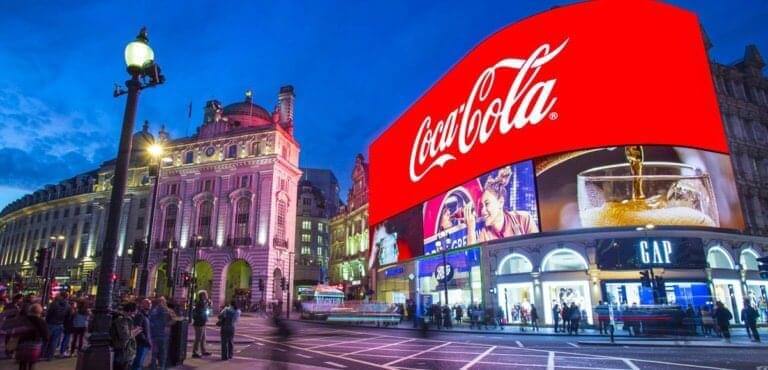
Since 2010, out-of-home (OOH) media has had consecutive revenue growth. Yes, you read that right, that’s 40 quarters and counting of consecutive growth! And there’s no coincidence for that. Despite being one of the oldest forms of advertising, OOH offers unparalleled benefits when it comes to multiple performance indicators. Some of the world’s biggest brands, including Apple, Google, Facebook, Disney, Warner Bros Pictures, Toyota, Comcast, State Farm, Amazon, McDonald’s, and Coca-Cola, have increasingly leveraged these advantages over the years in their quest for best consumer experience— some of which include:
- Creating high viewer engagement and interaction
- Motivating viewer action
- Generating mass targeted reach quickly
- Generating brand awareness and credibility
- Enhancing the impact of other media in omnichannel marketing (including digital/online/social media)
- Connecting brands with active and alert consumers
And OOH does all this at one of the lowest cost per thousand impressions (CPM) rates!
For all of the aforementioned reasons, it’s no wonder that household brands love OOH. So much so, that they spend more than the average 3.8% ad spend on OOH. According to a Global Ad Trends report from the World Advertising Research Centre (WARC) — the industry-leading source for marketing research — “successful brands allocate an average 13% of their media budget to out-of-home (OOH).”
Now, you’re probably wondering, “What difference does that additional 9.2% in OOH ad spend do for brands that helps amplify their advertising success?” And more importantly, why should we be paying attention? This article will cover everything from the effectiveness of OOH, to the impact of OOH in a multimedia mix, to examples of how big brands are using OOH — so that you can get a better idea of why your brand needs to hop on the OOH train.
Let’s Talk Numbers: OOH Compared to Other Media
Reach
It’s no surprise that as a highly accessible medium that’s viewed by anyone who steps outside of their homes, OOH reaches a large audience. The latest Nielsen OOH Advertising Study found that OOH reaches 80% of the 16+ age demographic in the US every week and 90% of this audience every month. Not only is outdoor media reaching a large audience on a regular basis, but it’s also reaching them when they’re more alert, more active, and most importantly, not distracted by their phones! Whether people are driving to work, walking to school, or shopping at the mall, they’re 33% more alert when they’re outside of their homes — leading to lasting brand impressions.
By comparison, other traditional mediums like TV, radio, and print are gradually receiving less viewership due to the emerging trend of on-demand entertainment like streaming services and podcasts. Although people are consuming more digital media nowadays, they are equally as tech-savvy in blocking out intrusive and interruptive online ads. Around 30% of all internet users now use ad blockers, which means that although advertisers are displaying their ads on digital platforms, it’s likely that they’re not actually being viewed by their intended audiences.
Cost-Effectiveness
Research studies have repeatedly shown that OOH significantly lowers the cost of advertising for businesses. Popular ad mediums — such as online advertising — can cost up to $17.50 per 1000 impressions, magazines can cost up to $21.00, and spot broadcast or cable can cost $22.00 – $25.00. In stark contrast, OOH reaches the equivalent number of consumers at a low cost of roughly $3.38 – $8.65, depending on the format. Radio is the only other format with comparable CPM rates to OOH, but as mentioned earlier, is becoming a more obsolete form of media.
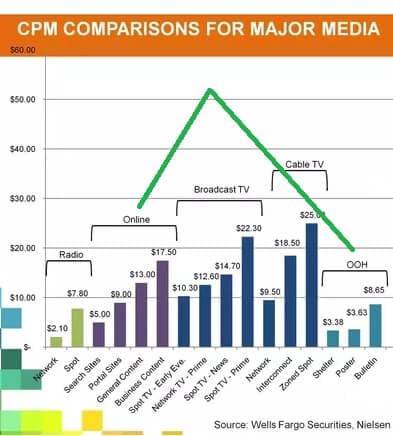
Return on Investment (ROI)
According to the Outdoor Advertising Association of America, (the national trade association for the OOH advertising industry) for each dollar spent on OOH advertising, an average of $2.80 is generated in product sales. By comparison, the ROI values for other advertising mediums, like TV ($2.43) and print ($2.41), are lower. Whereas, the ROI value for radio ($3.14), and online ($3.38), are higher. In terms of traditional mediums, while TV and radio are high in diminishing returns, OOH delivers linear incremental returns, offering consistent ROI growth.
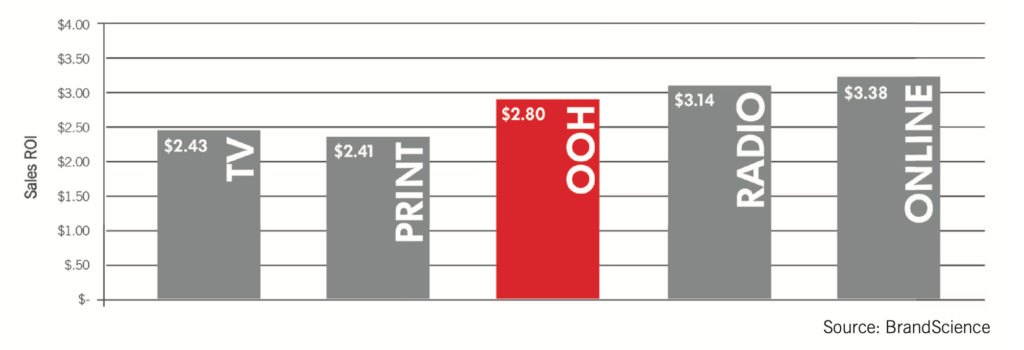
Impact of OOH in Multimedia Mix
While it’s no secret to most media planners that OOH is efficient and cost-effective, many of them may not know that OOH can actually dramatically improve the reach of other media when used in unison, AND at a lower cost. This is because OOH advertising serves as a strong support medium for other such mediums, by amplifying and reinforcing cross-channel messaging. According to a USA Touchpoints Study, when OOH is added to a media plan, it can increase reach by up to 18% for TV, 68% for online, 45% for radio, 212% for social networking, and a whopping 316% for mobile!
In the words of OAAA’s Chief Marketing Officer Stephen Freitas, “Using OOH in any campaign makes it more effective,” and “[…] advertisers see their sales grow and brand awareness increase when OOH is used in the media mix.”
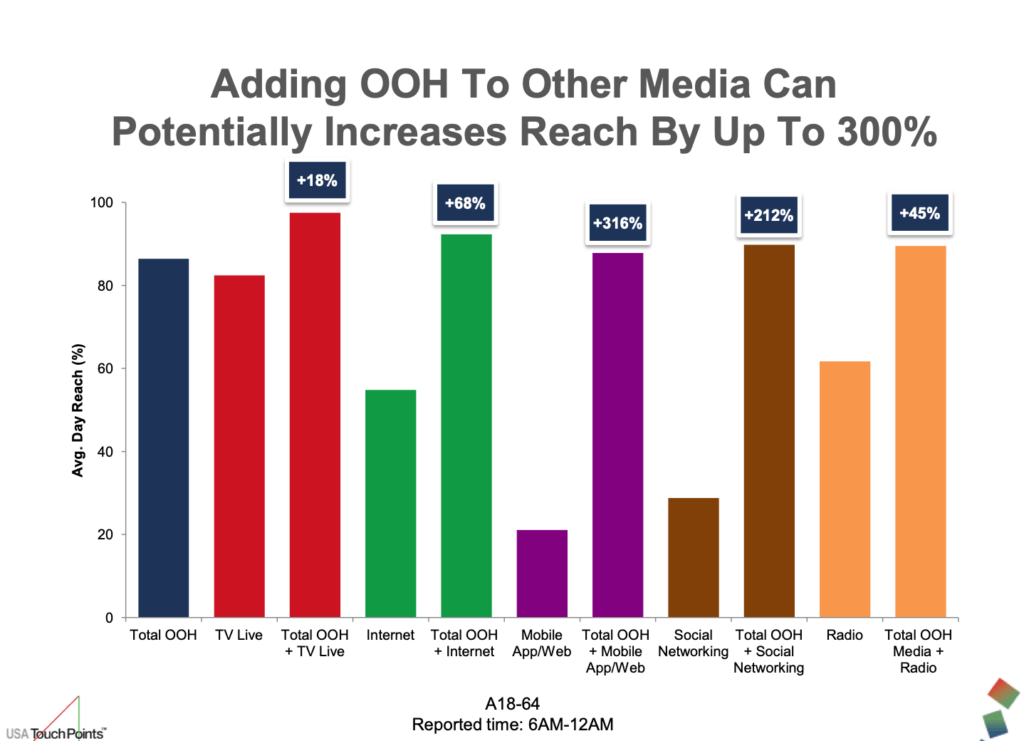
Big (Successful) Brands Spend MORE on OOH
If there’s one common theme that runs through the largest national advertisers marketing schemes it’s that they all spend MORE on OOH. And as the WARC mentioned in their Global Ad Trends report, perhaps investing in OOH is what is partially responsible for propelling these brands to the top of their respective industries. Here are just a few of the best examples of how big brands, who also happen to be some of the biggest spenders in OOH, are utilizing the ad medium.
Apple
In 2015, Apple launched its first-ever “Shot on iPhone” OOH campaign. Following astonishing success and praise from many industry experts, Apple has since continued to run this campaign for over 5 years now, most notably every fall when they roll out their launch ads for the new iPhone. Featuring user-generated content (UGC), Apple’s billboards tap into consumers’ need for authentic ads they can connect with. Instead of touting the technical aspects of the new iPhone camera, Apple shows consumers exactly what they’re missing out on by not purchasing the latest iPhone model. As one of the Top OOH advertisers in 2019, every brand can definitely learn something from Apple when it comes to leveraging the power of OOH to create brand loyalty.
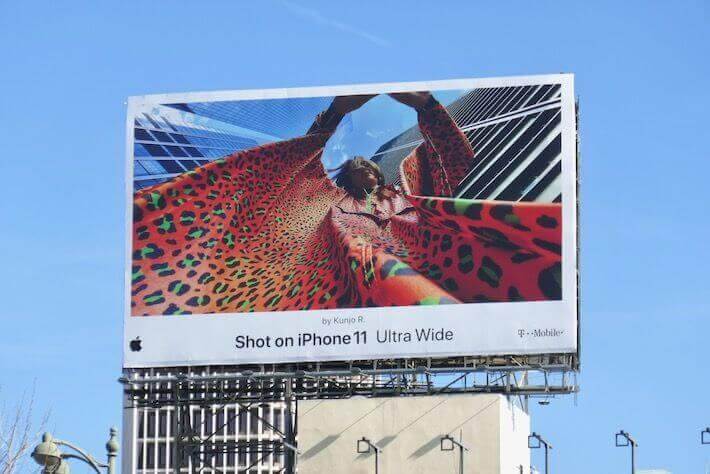
McDonald’s
There are many reasons as to why quick-service restaurants (QSRs) should invest in OOH — the most notable of which, include driving local traffic, driving mobile traffic, leveraging geofencing and location data, and tracking demographics and attributions. The fast-food giant, McDonald’s, is no stranger to taking advantage of these perks of OOH. McDonald’s has dominated the outdoor world — from billboards to bus shelters, bus wraps to mall displays — promoting their dollar summer drinks, new burgers, and other hot new menu items. As the second-largest OOH advertiser in 2019 (right behind Amazon), here are some noteworthy campaigns that McDonald’s has created in recent years:
McDonald’s Directional Billboards: It only takes the iconic red and yellow Golden Arches for us to think — McDonald’s! That’s the power of their ingenious branding — what makes them recognizable internationally . In 2018, McDonald’s took advantage of this fact and launched billboards with a minimalist design that gave drivers simple directions to their nearest restaurant location. Upon viewing the billboard below, for example, we wouldn’t even question where turning right would lead us to, as our mouths would already be watering for a McFlurry, a McChicken, or Happy Meal.
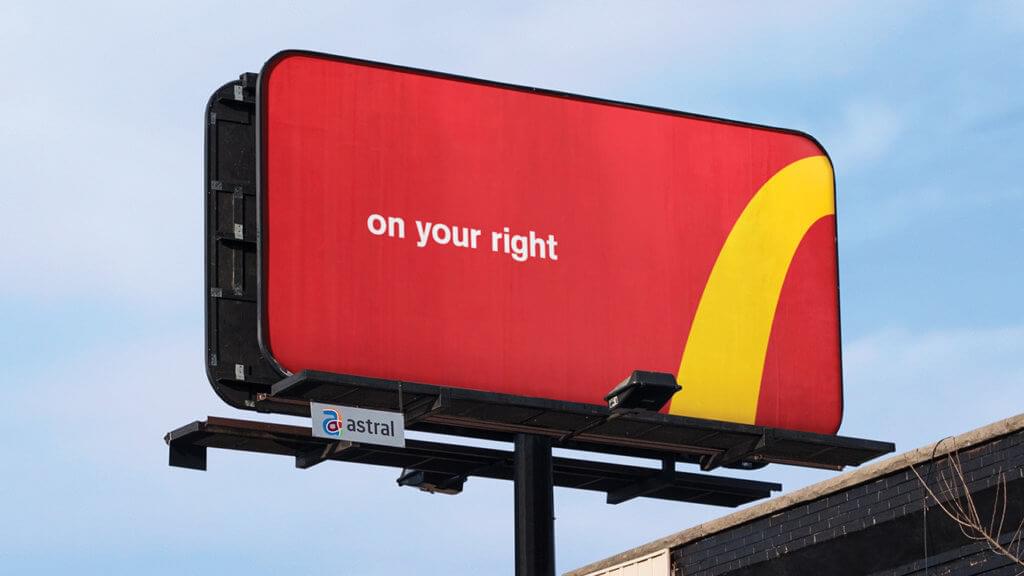
McDonald’s Tells You the Weather: Designed by Leo Burnett London, McDonald’s launched a billboard using MET Office real-time data that showed the weekly UK weather forecast. For example, an unwrapped burger represents the sun, while an upturned box of fries signifies rain. There were eight different icons in total to show how volatile spring weather can be in the UK. This campaign brilliantly tied together Britain’s favorite topic of conversation with the fast food chain’s delicious menu offerings — a form of personalized marketing all brands can learn from in their OOH advertising.
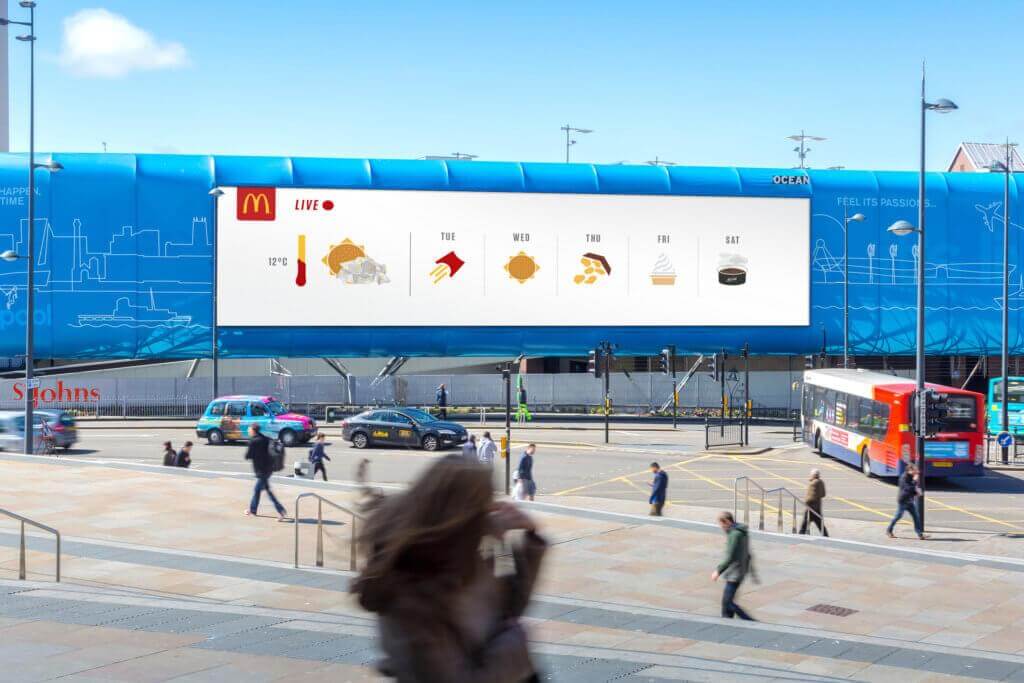
McDonald’s goes Brand-free: When you’re one of the biggest fast-food chains in the world, you really don’t need to be over-selling your brand anymore, now do you? In the early months of 2020, McDonald’s launched a simple, yet unmistakable, OOH campaign featuring billboards with merely the words of the ingredients of their famous breakfast and lunch sandwiches. Instead of showing pictures of their product, McDonald’s allowed for its audience to imagine the sandwiches themselves — which made the ads more impactful. This memorable campaign truly showed that, when it comes to ad design, less is more.
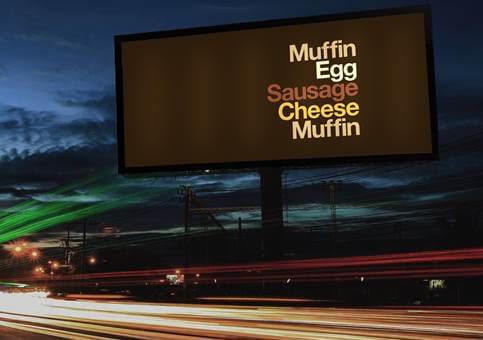
Coca-Cola
Last, but certainly not least, is everyone’s favorite beverage brand. Coca-Cola’s use of OOH advertising has been nothing but innovative, awe-inspiring, and captivating — securing its place as one of the most recognized and symbolic brands around the world. Since launching their first sign in Times Square nearly a century ago, the Atlanta-based brand has masterfully reinvented OOH by implementing the industry’s newest technological trends. Exceeding all expectations for a beverage brand, here are some of Coca-Cola’s iconic OOH campaigns that have rocked the ad world:
Coca-Cola’s Sensory Experience: In August of 2017, Coca-Cola launched a 3D robotic billboard in NYC’s Times Square. Featuring over 1,700 LED screens that could move independently of one another with programmed choreography, the shifting billboard changed images with a motion like a “slow wave of water”. This OOH project was the first of its kind, took over 4 years of engineering and testing to create, and earned Coca-Cola 2 Guinness World records — the first 3D robotic billboard and the largest 3D robotic billboard. As if that wasn’t impressive enough, Coca-Cola also partnered up with the Times Square Museum to provide onlookers with beverage samples — truly providing a 360-degree sensory ad experience.
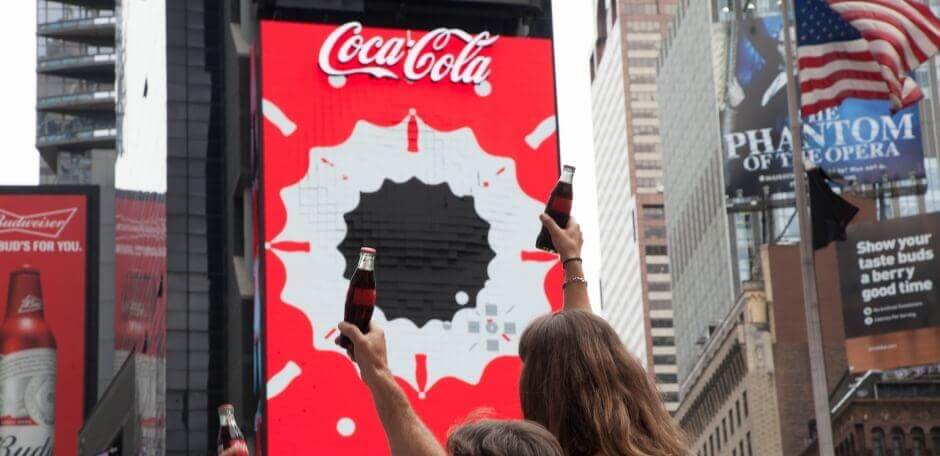
Coca-Cola’s Interactive Vending Machines: It only makes sense for a beverage brand to leverage vending machines to expand its outdoor presence. Coca-Cola, however, has once again taken this OOH media format to a whole new level. In Singapore, for example, they surprised college students with a vending machine that would release a free Coke if they hugged it in a particular way.
Another notable example of this innovative technology, was when Coca-Cola encouraged camaraderie across the Indian-Pakistani border. Coca-Cola installed machines in both countries that would release a free Coke when people from across the border virtually touched hands together or danced together on the digital screens of the vending machines.
Coca-Cola Christmas Trucks: Since their TV debut in 1995, Coca-Cola Christmas caravans have become an emblem of the beginning of the winter holidays. The advertisement was so successful that in 2001, Coca-Cola decided to roll-out real trucks all over the world. With over 30,000 bright light bulbs twinkling to a festive Christmas music soundtrack and sleigh bells chiming, the trucks drew in large audiences wherever they went. From 2011 to 2015 alone, over 3.5 million visitors came to see the trucks, with some even waiting hours in line for a free Coke, in the United Kingdom.
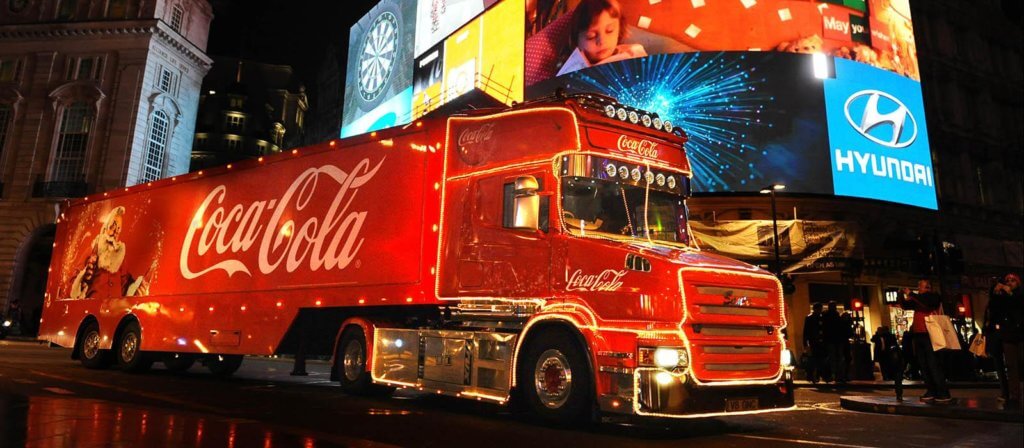
Final Thoughts
There’s overwhelming evidence pointing to the fact that much of the continued success of major household brands can be attributed to their strategic OOH expansion strategies. If you’re worried that your brand doesn’t nearly have as much ad budget to work with as some of the industry giants, don’t fret, because a small impact in the outdoor arena is better than no impact at all. As Omnicom Media Group’s Benchmarketing advises, “OOH share of budgets of all sizes — small, medium, and large — should be increased 2 to 3 times over current allocations.” Whether you’re the business owner of a small startup or a marketer of a large business, get a head start on expanding your company’s outdoor presence today and reap the benefits for many more years to come.


